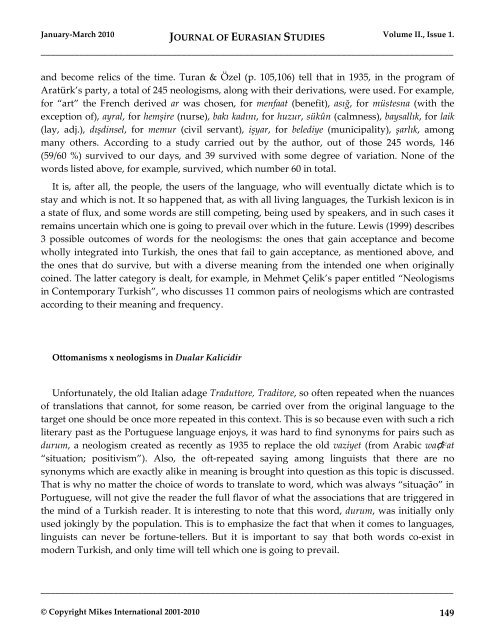EurasianStudies_0110..
EurasianStudies_0110..
EurasianStudies_0110..
Create successful ePaper yourself
Turn your PDF publications into a flip-book with our unique Google optimized e-Paper software.
January-March 2010 JOURNAL OF EURASIAN STUDIES Volume II., Issue 1.<br />
_____________________________________________________________________________________<br />
and become relics of the time. Turan & Özel (p. 105,106) tell that in 1935, in the program of<br />
Aratürk’s party, a total of 245 neologisms, along with their derivations, were used. For example,<br />
for “art” the French derived ar was chosen, for menfaat (benefit), asığ, for müstesna (with the<br />
exception of), ayral, for hemşire (nurse), bakı kadını, for huzur, sükûn (calmness), baysallık, for laik<br />
(lay, adj.), dışdinsel, for memur (civil servant), işyar, for belediye (municipality), şarlık, among<br />
many others. According to a study carried out by the author, out of those 245 words, 146<br />
(59/60 %) survived to our days, and 39 survived with some degree of variation. None of the<br />
words listed above, for example, survived, which number 60 in total.<br />
It is, after all, the people, the users of the language, who will eventually dictate which is to<br />
stay and which is not. It so happened that, as with all living languages, the Turkish lexicon is in<br />
a state of flux, and some words are still competing, being used by speakers, and in such cases it<br />
remains uncertain which one is going to prevail over which in the future. Lewis (1999) describes<br />
3 possible outcomes of words for the neologisms: the ones that gain acceptance and become<br />
wholly integrated into Turkish, the ones that fail to gain acceptance, as mentioned above, and<br />
the ones that do survive, but with a diverse meaning from the intended one when originally<br />
coined. The latter category is dealt, for example, in Mehmet Çelik’s paper entitled “Neologisms<br />
in Contemporary Turkish”, who discusses 11 common pairs of neologisms which are contrasted<br />
according to their meaning and frequency.<br />
Ottomanisms x neologisms in Dualar Kalicidir<br />
Unfortunately, the old Italian adage Traduttore, Traditore, so often repeated when the nuances<br />
of translations that cannot, for some reason, be carried over from the original language to the<br />
target one should be once more repeated in this context. This is so because even with such a rich<br />
literary past as the Portuguese language enjoys, it was hard to find synonyms for pairs such as<br />
durum, a neologism created as recently as 1935 to replace the old vaziyet (from Arabic waḍī c at<br />
“situation; positivism”). Also, the oft-repeated saying among linguists that there are no<br />
synonyms which are exactly alike in meaning is brought into question as this topic is discussed.<br />
That is why no matter the choice of words to translate to word, which was always “situação” in<br />
Portuguese, will not give the reader the full flavor of what the associations that are triggered in<br />
the mind of a Turkish reader. It is interesting to note that this word, durum, was initially only<br />
used jokingly by the population. This is to emphasize the fact that when it comes to languages,<br />
linguists can never be fortune-tellers. But it is important to say that both words co-exist in<br />
modern Turkish, and only time will tell which one is going to prevail.<br />
_____________________________________________________________________________________<br />
© Copyright Mikes International 2001-2010 149

















